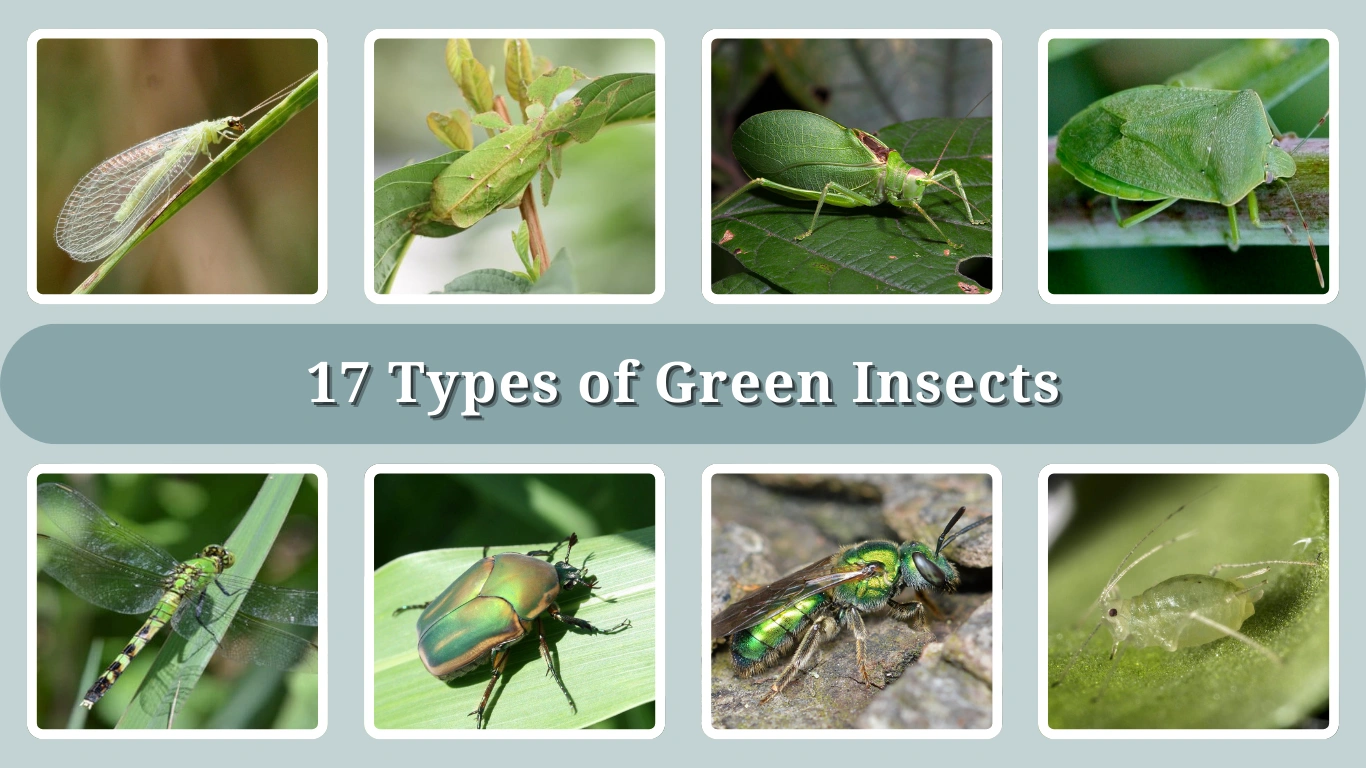Green is one of the most common and useful colors in the insect world, providing camouflage among leaves, grasses, and plants. From tiny aphids to large stick insects and shimmering metallic beetles, these creatures display a fascinating variety of shapes and adaptations. Some are helpful pollinators or natural pest controllers, while others can be agricultural pests. This guide introduces 17 remarkable green insects, highlighting their appearance, behaviors, lifecycles, and ecological importance.
1. Green Lacewing (Chrysoperla carnea)
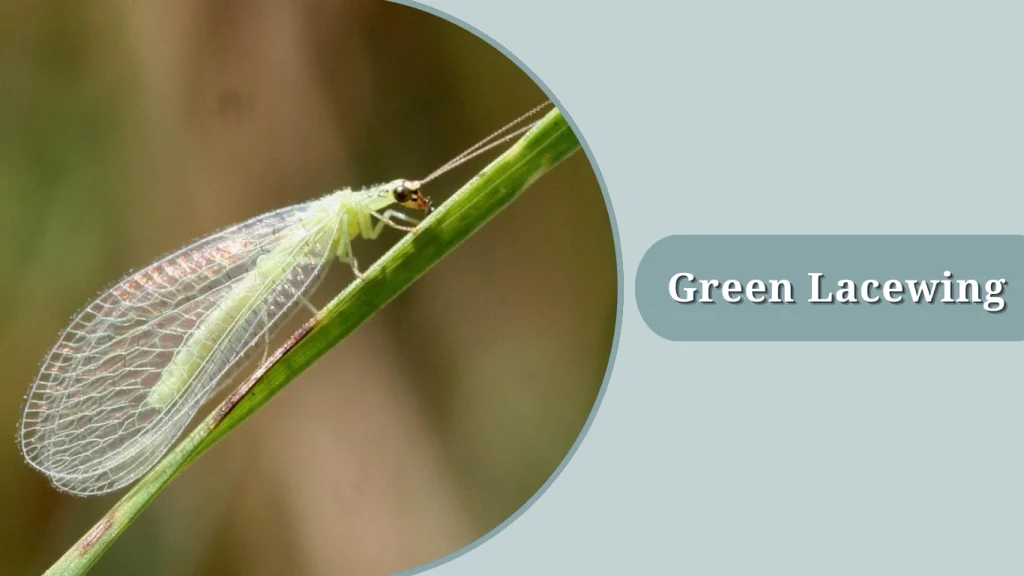
The Green Lacewing is a delicate insect recognized for its fragile beauty and important role in pest control. Often spotted in gardens, it is sometimes described simply as a green insect with clear wings because of its glasslike appearance and soft green body.
Identification
- Slender, bright green body
- Two pairs of large, transparent, veined wings
- Long, threadlike antennae
- Golden or copper-colored eyes
- Adults measure 10–20 mm in length
Habitat
Common in gardens, forests, fields, and agricultural areas across North America, Europe, and Asia. Often rests on plants at night, drawn to lights.
Behaviors
Adults are weak fliers but active at dusk and night. Larvae are voracious predators, sometimes called “aphid lions” for their habit of hunting plant pests.
Lifecycle & Lifespan
Eggs are laid on the tips of slender stalks on plants. Larvae pass through three instars before pupating in silken cocoons. Adults live a few weeks to several months depending on climate.
Diet
- Larvae: feed on aphids, whiteflies, thrips, and small caterpillars
- Adults: consume nectar, pollen, and honeydew
2. Leaf Insect (Phyllium spp.)
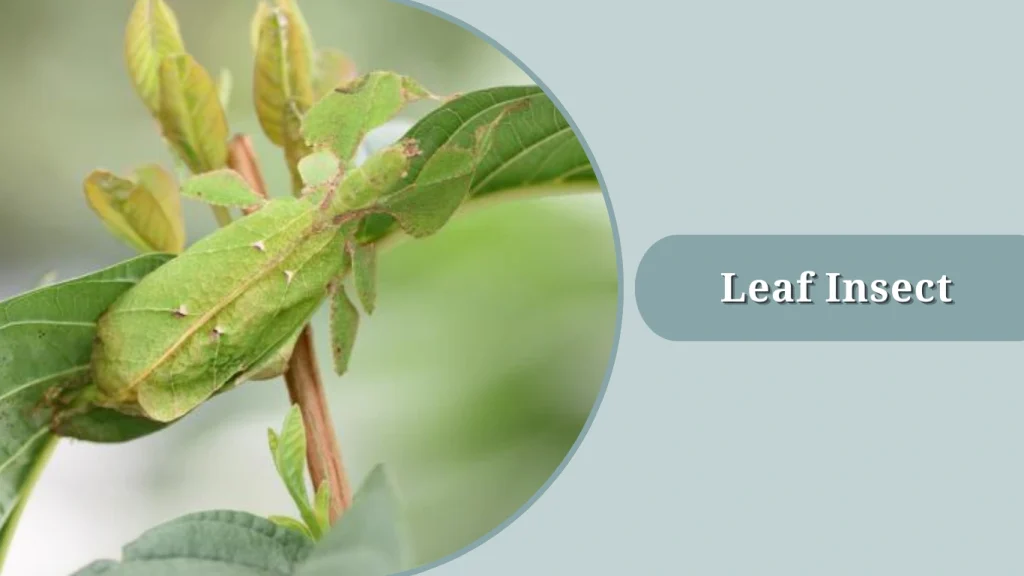
The Leaf Insect is one of nature’s best examples of camouflage. Frequently described as a green insect that looks like a leaf, it has evolved to resemble foliage so precisely that it is nearly invisible when resting among plants. Its wings, body, and even legs mimic the veins and edges of a real leaf.
Identification
- Flattened, leaf-shaped body with intricate vein-like patterns
- Bright green coloration, sometimes with brown patches imitating leaf damage
- Long antennae and short, leaflike wings (females less capable of flight)
- Medium to large size: 2–4 inches depending on species
- Legs often widened and patterned to look like leaf edges
Habitat
Native to tropical forests of Southeast Asia, particularly Malaysia, Indonesia, and the Philippines. They spend their lives clinging to leaves in trees and shrubs, blending perfectly with foliage.
Behaviors
Masters of mimicry, they sway gently like leaves when disturbed, enhancing their disguise. Primarily nocturnal, they feed at night and remain motionless during the day to avoid predators.
Lifecycle & Lifespan
Females lay eggs that resemble seeds, which drop to the forest floor and remain dormant for months before hatching. Leaf insects live 8–12 months, with females often living longer than males.
Diet
Strictly herbivorous, feeding on guava, mango, oak, and other broadleaf plants.
3. Common True Katydid (Pterophylla camellifolia)
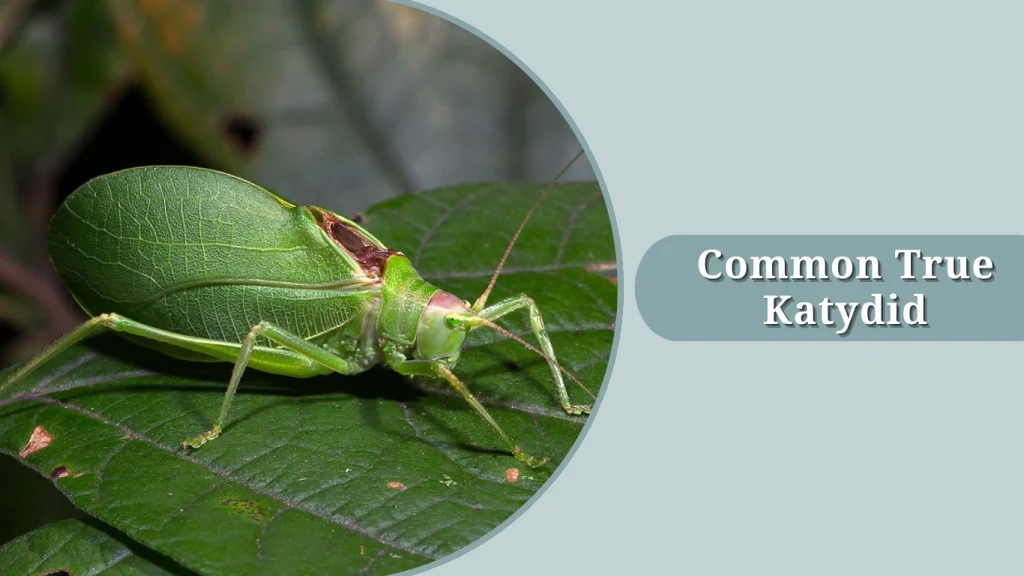
The Common True Katydid is a large, bush-dwelling insect in North America. Its body so closely resembles a leaf that it is often identified as a green insect that looks like a grasshopper, though it is more closely related to crickets. Its powerful hind legs and long antennae make it a remarkable jumper and climber.
Identification
- Bright green body shaped like a leaf, complete with veinlike wing patterns
- Long, slender antennae often longer than the body
- Size ranges from 1.5–2 inches in length
- Strong hind legs adapted for jumping
- Rounded wings that mimic foliage perfectly
Habitat
Common in deciduous forests and woodlands of the eastern United States. Found on trees, bushes, and tall grasses where it blends seamlessly with leaves.
Behaviors
Nocturnal singers, males produce loud “katy-did, katy-didn’t” calls during summer nights. They are arboreal, rarely descending to the ground, and rely heavily on camouflage to avoid predators.
Lifecycle & Lifespan
Eggs are laid on bark or plant stems and hatch the following spring. Nymphs resemble small wingless adults and molt several times before reaching maturity. Adults live through late summer and fall.
Diet
Herbivorous, feeding on leaves of trees and shrubs such as oak, cherry, and bramble. Occasionally nip flowers and fruits.
4. Great Green Bush-Cricket (Tettigonia viridissima)

The Great Green Bush-Cricket is one of the largest bush-crickets in Europe. Frequently mistaken for a green grasshopper insect, it is actually a close relative of katydids and crickets. Its large size and powerful legs make it an impressive sight in meadows and hedgerows.
Identification
- Long, slender body in bright leaf-green
- Long wings extend well past the abdomen
- Exceptionally long antennae, often twice the body length
- Adults reach 28–40 mm in length
- Hind legs strong and spined for jumping
Habitat
Found throughout Europe and parts of western Asia. Prefers meadows, grasslands, forest edges, and tall vegetation where its green body blends into the plants.
Behaviors
Males produce a loud, continuous chirping song in summer, especially at dusk. Agile climbers, they spend most of their lives in tall grasses and shrubs. Though mostly harmless, they can deliver a strong bite if handled carelessly.
Lifecycle & Lifespan
Eggs are laid in soil or plant stems during autumn, overwintering until spring. Nymphs resemble wingless adults and undergo multiple molts before maturing. Adults live through summer and early autumn.
Diet
Omnivorous: feeds on grasses, leaves, and small insects such as caterpillars, flies, and aphids.
5. European Mantis (Mantis religiosa)

The European Mantis is a fascinating predatory insect and one of the most iconic mantises. Often called a green mantis insect, it is admired for its graceful stance, folded forelegs, and ability to blend into vegetation.
Identification
- Slender green or brown body, 5–7 cm long
- Distinctive raptorial forelegs lined with spines for grasping prey
- Triangular head with large compound eyes and flexible neck
- Wings folded along the back, sometimes with transparent tips
- Both males and females capable of flight, though females are heavier
Habitat
Native to Europe, Asia, and Africa but also introduced to North America. Found in gardens, meadows, and farmlands where it perches on plants awaiting prey.
Behaviors
Ambush predator: remains motionless until prey approaches, then strikes with lightning speed. Exhibits the characteristic “praying” posture. Males are known for cautious mating behavior due to the risk of sexual cannibalism.
Lifecycle & Lifespan
Females lay eggs in a foamy case called an ootheca, which hardens for protection. Nymphs hatch in spring and resemble miniature adults. Lifespan is about 10–12 months.
Diet
Feeds on flies, grasshoppers, crickets, moths, and other insects. Large individuals may even capture small reptiles or amphibians.
6. Green Stink Bug (Chinavia hilaris)

The Green Stink Bug is a widespread shield bug in North America. Easily recognized by its shield-shaped body and bright coloring, it is sometimes called a green insect that bites, although it actually pierces plants rather than people.
Identification
- Broad, shield-shaped body in bright green
- Edges of wings often yellow or orange
- Adults measure 12–17 mm long
- Distinctive triangular scutellum on the back
- Emits a strong odor when threatened
Habitat
Common in gardens, fields, and agricultural crops across the U.S. and Canada. Often seen on beans, soy, corn, and tomatoes, where it feeds on plant sap.
Behaviors
Slow-moving and diurnal, it hides in foliage when disturbed. Uses piercing-sucking mouthparts to extract juices from fruits, leaves, and stems. Releases a foul-smelling liquid as a defense.
Lifecycle & Lifespan
Overwinters as an adult under leaf litter. Females lay clusters of barrel-shaped eggs on the underside of leaves. Nymphs pass through five stages before becoming adults. Lives several months.
Diet
Feeds mainly on plant juices, including beans, soybeans, corn, and tomatoes. Considered an agricultural pest.
7. Green Darner Dragonfly (Anax junius)

The Green Darner is one of the largest and most recognizable dragonflies in North America. Known as a large flying green insect, it is admired for its bright coloring and powerful flight.
Identification
- Bright green thorax with a long blue or brown abdomen
- Large, clear wings with dark veins
- Wingspan up to 11 cm (4–4.5 inches)
- Eyes large and rounded, covering most of the head
- Strong, agile fliers capable of long migrations
Habitat
Found near lakes, ponds, rivers, and marshes across North and Central America. Often seen patrolling open water or resting on vegetation.
Behaviors
Strong fliers that can migrate hundreds of miles. Males are territorial, often patrolling the same stretch of water. Known for hovering in place while hunting.
Lifecycle & Lifespan
Eggs are laid in aquatic plants. Nymphs (naiads) live underwater for up to 2 years before emerging to molt into adults. Adults live 1–2 months, though some migrate south to extend survival.
Diet
- Nymphs: aquatic insects, tadpoles, small fish
- Adults: mosquitoes, flies, moths, and other flying insects captured in flight
8. Green June Beetle (Cotinis nitida)

The Green June Beetle is a large, metallic insect often buzzing loudly through summer fields and gardens. Its shimmering body makes it easily recognized as a big green insect with wings and sometimes confused with similar beetles.
Identification
- Metallic green upper body with golden or bronze highlights
- Underside bright iridescent green
- Large, oval-shaped body, 20–25 mm long
- Strong wings that produce a loud buzzing sound in flight
- Clubbed antennae that detect plant odors
Habitat
Found across the eastern United States, especially in pastures, orchards, and gardens. Adults are most active in summer, often feeding on fruit.
Behaviors
Clumsy fliers that buzz noisily in daylight. Adults gather on ripening fruit in large numbers. Larvae (white grubs) live in soil, feeding on decaying organic matter and plant roots.
Lifecycle & Lifespan
Eggs are laid in soil during summer. Grubs develop over the year, pupate in the soil, and emerge as adults the following summer. Adults live several weeks.
Diet
- Adults: feed on fruit, such as grapes, peaches, and apples
- Larvae: consume roots and decaying vegetation
9. Figeater Beetle (Cotinis mutabilis)

The Figeater Beetle, a close relative of the Green June Beetle, is a bright metallic insect of the American Southwest. Frequently seen in gardens, it is recognized as a bright green insect with wings and sometimes a large green flying insect.
Identification
- Shiny emerald-green body with bronze wing covers
- Underside bright metallic green
- Slightly smaller than Green June Beetle: 20–23 mm
- Loud, buzzing flight during hot afternoons
- Soft elytra (wing cases), giving a velvety texture
Habitat
Native to the southwestern United States and Mexico. Common in gardens, orchards, and compost piles, especially in late summer.
Behaviors
Adults are diurnal and strong fliers, often seen clumsily buzzing over fruit trees. Larvae, called “crawly backs,” move on their backs using bristles rather than legs.
Lifecycle & Lifespan
Eggs are laid in compost, manure, or rich soil. Larvae feed for several months before pupating. Adults emerge in summer and live a few weeks to two months.
Diet
- Adults: feed on soft, ripe fruit such as figs, peaches, and plums
- Larvae: consume decaying plant matter and compost
10. Emerald Ash Borer (Agrilus planipennis)

The Emerald Ash Borer is a small, metallic beetle that has become infamous as an invasive species. Its brilliant coloring has led people to describe it as a blue green insect or even a green and black insect depending on the light.
Identification
- Slender, metallic emerald-green body with iridescent blue-green tones
- Coppery red or purple abdomen visible beneath wing covers
- Small size: 8–14 mm long
- Narrow, bullet-shaped body
- Distinct ridged wing cases
Habitat
Native to Asia but now invasive in North America and Europe. Found wherever ash trees grow, as the larvae bore into and feed on the wood.
Behaviors
Adults emerge in late spring and can fly short distances, though they spread rapidly through infested areas. Their larvae tunnel beneath tree bark, disrupting nutrient flow and eventually killing the tree.
Lifecycle & Lifespan
Females lay eggs in bark crevices. Larvae feed inside ash trees for several months, pupate, and emerge as adults the following year. One generation per year in most climates.
Diet
- Adults: feed on ash tree leaves
- Larvae: bore into ash wood and feed on inner bark and phloem
11. Green Tiger Beetle (Cicindela campestris)

The Green Tiger Beetle is a fierce predator often described as a bright green insect or a green and black insect due to its metallic sheen and dark markings. It is admired for both its speed and hunting ability.
Identification
- Shiny green body with bronze or blue reflections
- Distinct pale spots on wing covers
- Long legs adapted for running at high speed
- Prominent sickle-shaped jaws
- Adults 10–15 mm in length
Habitat
Found across Europe, Asia, and parts of North America. Prefers sandy paths, grasslands, heaths, and open sunny areas.
Behaviors
One of the fastest running insects, capable of chasing down prey. Aggressive hunters that capture insects on the ground. Strong fliers but prefer to run in short bursts.
Lifecycle & Lifespan
Eggs are laid in soil burrows. Larvae live in vertical tunnels, ambushing passing insects. Adults live one to two years, with larvae developing over several months.
Diet
Strictly carnivorous: feeds on ants, flies, caterpillars, and other small insects.
12. Green Sweat Bee (Agapostemon texanus)

The Green Sweat Bee is a dazzling pollinator often noticed in gardens. With its shimmering body, it is sometimes mistaken for a green stinging insect, though it is far less aggressive than wasps or hornets.
Identification
- Bright metallic green head and thorax
- Females are entirely green; males often have striped abdomens
- Small size: 7–12 mm in length
- Six legs, long antennae, and clear wings
- Compact, slender body adapted for fast flight
Habitat
Common across North and South America. Found in meadows, gardens, and farmlands where flowers are abundant. Nests are typically dug into soil or sandy banks.
Behaviors
Solitary to semi-social, with females often sharing nest entrances but maintaining separate brood cells. Attracted to human sweat for salts, which gave them their name. Not aggressive unless handled.
Lifecycle & Lifespan
Females dig burrows in soil where they lay eggs in chambers provisioned with pollen and nectar. One or more generations may occur each year, depending on climate. Adults live a few weeks to months.
Diet
- Adults: feed on nectar and pollen, serving as important pollinators
- Larvae: consume stored pollen and nectar in brood chambers
13. Cuckoo Wasp (Chrysis ignita)

The Cuckoo Wasp is a brilliantly colored insect that shimmers in metallic hues. It is often described as a metallic blue green flying insect and is one of the most striking wasps worldwide.
Identification
- Metallic blue-green body with iridescent shimmer
- Small, compact size: 6–12 mm
- Hardened exoskeleton allows curling into a defensive ball
- Distinct sculptured surface with pits and grooves
- Narrow waist typical of wasps
Habitat
Found throughout Europe, Asia, and North America. Common around sunny walls, dead wood, and bee nesting sites, since they parasitize other insects.
Behaviors
Parasitic: females lay eggs in the nests of solitary bees or wasps. The larvae consume the host’s eggs, larvae, or food stores. Adults are fast fliers and difficult to catch.
Lifecycle & Lifespan
Eggs are deposited secretly in host nests. Larvae develop quickly, pupate, and emerge as adults. Adults live only a few weeks.
Diet
- Adults: feed on nectar from flowers
- Larvae: parasitic, feeding on host bee or wasp provisions
14. Potato Leafhopper (Empoasca fabae)

The Potato Leafhopper is a tiny but destructive insect, often noticed as a small green flying insect in gardens and fields. Despite its delicate appearance, it is considered a serious agricultural pest.
Identification
- Small, wedge-shaped body about 3 mm long
- Bright lime-green coloration
- Clear wings held rooflike over the body
- Long hind legs for quick jumps
- Six legs and slender antennae
Habitat
Native to North America, especially common in the eastern United States. Found in fields, gardens, and orchards, where it lives on the underside of leaves.
Behaviors
Extremely active and quick, able to leap or fly at the slightest disturbance. Causes “hopper burn” on plants by piercing and sucking sap, leading to yellowing and curling leaves.
Lifecycle & Lifespan
Multiple generations occur each summer. Eggs are inserted into plant tissue, hatch into wingless nymphs, and mature into adults in about two weeks. Adults live 1–2 months.
Diet
Feeds on plant sap, especially from beans, potatoes, alfalfa, and clover.
15. Green Peach Aphid (Myzus persicae)
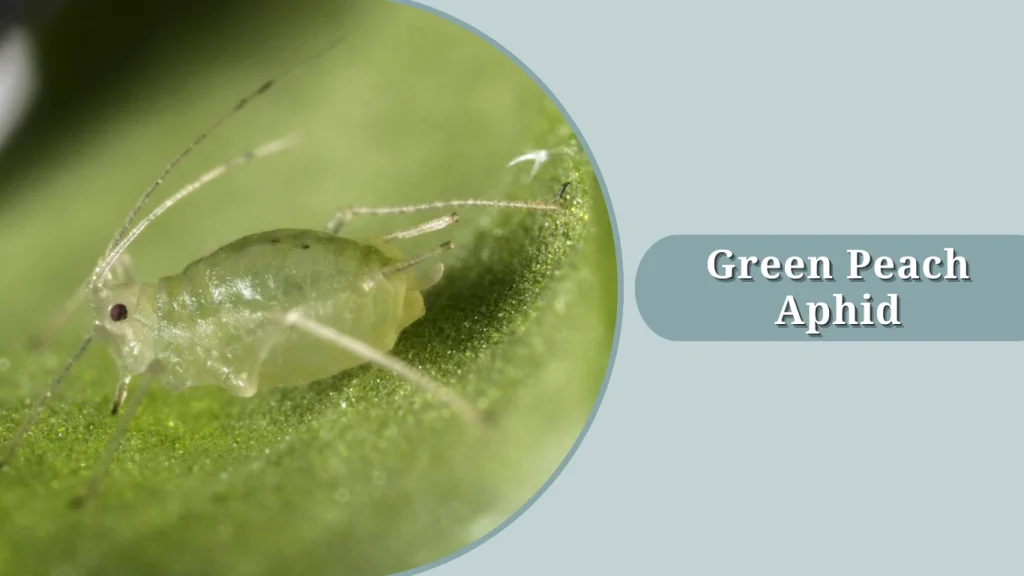
The Green Peach Aphid is one of the most widespread garden pests worldwide. Often called a little green insect on plants, it can infest roses, vegetables, and fruit trees in large numbers.
Identification
- Tiny, pear-shaped body: 1–3 mm long
- Light green to yellow-green coloration
- Soft-bodied with long antennae and legs
- Some winged forms, others wingless
- Colonies often cluster on stems and leaf undersides
Habitat
Found worldwide, especially in temperate and subtropical regions. Common in gardens, greenhouses, and fields where they colonize vegetables and flowers.
Behaviors
Reproduce rapidly by live birth (parthenogenesis), allowing colonies to explode in size within days. Known for transmitting plant viruses, making them a major agricultural concern.
Lifecycle & Lifespan
Can reproduce both sexually and asexually. In warm climates, generations continue year-round. Individual aphids live 2–4 weeks, but populations remain constant through continuous breeding.
Diet
Feeds on plant sap, weakening host plants and often leaving behind sticky honeydew that encourages mold growth.
16. Cone-Headed Grasshopper (Acrida conica)

The Cone-Headed Grasshopper is a slender, elongated insect often mistaken for a green grasshopper insect. Its pointed head and narrow body help it blend seamlessly into tall grasses.
Identification
- Long, cylindrical body in light to bright green
- Distinctive cone-shaped head
- Very long legs and antennae
- Narrow wings folded tightly along the body
- Adults measure 30–50 mm in length
Habitat
Found in grasslands, meadows, and wetlands across Europe, Asia, and parts of Africa. Prefers tall vegetation where its slim body provides camouflage.
Behaviors
Mostly active during the day. Uses strong hind legs for jumping long distances. Males produce a buzzing call at night by rubbing their wings together.
Lifecycle & Lifespan
Eggs are laid in soil, overwintering until spring. Nymphs resemble miniature adults and go through several molts before reaching maturity in summer. Adults live through late summer and fall.
Diet
Feeds on grasses, weeds, and other herbaceous plants.
17. Indian Stick Insect (Carausius morosus)

The Indian Stick Insect is one of the best masters of disguise in the insect world. Commonly kept as a pet, it is often identified as a green stick insect because of its twiglike body that mimics plant stems.
Identification
- Long, thin, cylindrical body resembling a twig
- Light to medium green in color, sometimes brownish
- Adults measure 8–10 cm in length
- Wingless with long legs and antennae
- Females larger and more robust than males
Habitat
Native to India but introduced to many countries worldwide through the pet trade. Found in gardens, forests, and farms where it feeds on leaves.
Behaviors
Nocturnal and extremely still during the day, relying on camouflage to avoid predators. If disturbed, may sway like a twig in the breeze for added disguise.
Lifecycle & Lifespan
Females can reproduce parthenogenetically (without males). Eggs resemble plant seeds and may take several months to hatch. Adults live 12–18 months.
Diet
Strictly herbivorous, feeding on bramble, ivy, oak, and other leafy plants.

